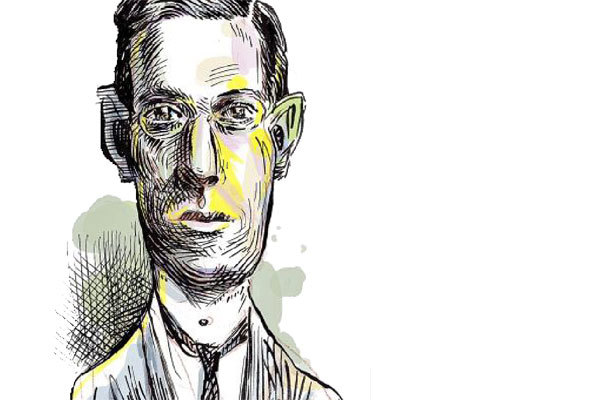- Lovecraft and Barcelona: a story of fascination
Lovecraft as enigma, brightness and immensity , also enters us in his poems, in that living terror of the ductile mirror that we find when reaching out to a threatening blackness. His stories are the germ of a popular reading that has found its germ between space octopuses and primitive ages of extraterrestrial magic; but we can also discover it in his poetry, as an encrypted radiography of a spirit that perhaps did not even reveal its intimate truth to itself. Here we will meet Howard Phillips Lovecraft in the iconic photograph taken by Lucius B. Truesdell in 1934: as someone on the prowl of their probable worlds , from their last escape into the fog. Thus, few features have been more accurately peered into the poetic intention of a man, that whole look and excessively absorbed in his own mystery . The abyssal and galactic worlds that Lovecraft envisioned were not beyond, but in its most here , in an intimate and arcane region that he discovered in his early childhood, taking those walks through the forests of New England after the early death of his father, Winfield sales representative Scott Lovecraft, who left him with his loneliness scratch.
The Lovecraft boy was only eight years old when his father and mother, Sarah Susan Phillips, died reacting to his widowhood by living with his two sisters and pampering him in a tiny and concentric environment, under a strict code of distrust of any stranger who did not belonged to the already decadent upper class of New England. The boy Lovecraft, confined in himself, found the answer to his orphanhood in his long walks through the groves that still brought the whispers of Salem's winds. There is an invisible knot, a liquid string of time that unites that previous moment of loss - but also gain of itself -, with another much later, almost three decades later: when the man who is already 36 years returns to Providence, leaving behind the cordial ashes of his marriage and the attempt at literary life in a New York that did not open the door of any of its skyscrapers. So, again he would live with his aunts Lillian Delora Phillips and Annie Emeline Phillips; but without his protective mother, who had died six years before after a difficult disease , perhaps related to the father's old syphilis, plunging him into a depression that isolated him or that immersed him more in himself. I count those circumstances because they could well influence your bordering vision of the world and of life, between fear and serene beauty . And because it was when he returned to the one he always recognized as the only scenario of his happiness, Providence, with his aunts, when he began his definitive existence of progressive loneliness and hardship , of finishing between several editorials of survival. He sank into his obsessive night walks , not knowing where he was going: day after day, sometimes all night, getting lost in the shadows. That's when HB Lovecraft watched the horror, and decided to write it.
The shadow of Lovecraft is so elongated that it is even possible to know it without having read it. Only last year, coinciding with the 82nd anniversary of his death, again we could enjoy his complete stories in Valdemar, an illustrated edition of the story The Call of Cthulhu on Planet or his biography HP Lovecraft. Life and work illustrated by Agustín and Hernán Conde de Boeck. But do we really know Lovecraft? We think so. And precisely against this tendency of the present, the overexposure that reserves us a concealment in view of all, the intelligent prologue of Juan Andrés García Román, a brilliant poet of phosphorus splintered in the verb lights that gives us this translation of Un faint indeterminate ether (Yuggoth Fungi) edited by Pre-Texts. One of the things we make clear is that there is not a single Lovecraft : not even in his splendid poetry. In this magical and timeless turn that begins with Poe and ends with Alan Moore, Guillermo del Toro or Juan Francisco Ferré, Lovecraft represents the outbreak, that electricity from worlds before us that lurk from overseas and accompany us back, before discovering the form of terror that awaits us at home. Mysterious rites with their guilty background, the pulse or tension between the need to know and the punishments we receive for touching the truth.
This thirty long poems translated by the brilliant poet who is García Román immerses us in the essence of Lovecraft's work : it is the bone marrow of his narratives and reserves the same restlessness at the end of the corridor, in the depths or towards the sky carnivorous. A crack opens in the twilight over the horizon, there is a winged castle where the last of the old ancestors covered by their cloth mask awaits. But we can never discover the answer, because the final horror has no name and Lovecraft drags us across the darkness.
According to the criteria of The Trust Project
Know more- culture
- literature
Books in the attraction to the madness of Millás
The final interview Irene Vallejo, writer: "My father told me 'The Odyssey' one night as a child and transformed me into a mythomaniac"
The Paper SpherePaola Masino and the housewife against fascism

